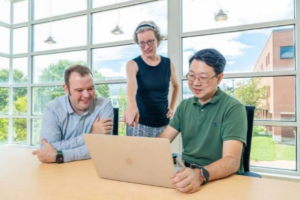 Offshore energy extraction is taking place off the coast of North Carolina, utilizing both conventional and emerging technologies such as wind turbines, hydrokinetic ocean current turbines, and wave energy conversion devices. Duke Energy, Total Energies, and Avangrid Renewables have secured leases for the Carolina Long Bay and other offshore wind energy areas in North Carolina as part of their goal to reduce carbon emissions and increase the use of renewable energy. Such activities support North Carolina’s Executive Order Number 80, Commitment to Address Climate Change and Transition to a Clean Energy Economy. Dr. He and his research team along with his startup company Fathom Science have been engaging with Duke Energy and Avangrid Renewables to provide metocean modeling information to support their offshore wind farm micro siting and operations.
Offshore energy extraction is taking place off the coast of North Carolina, utilizing both conventional and emerging technologies such as wind turbines, hydrokinetic ocean current turbines, and wave energy conversion devices. Duke Energy, Total Energies, and Avangrid Renewables have secured leases for the Carolina Long Bay and other offshore wind energy areas in North Carolina as part of their goal to reduce carbon emissions and increase the use of renewable energy. Such activities support North Carolina’s Executive Order Number 80, Commitment to Address Climate Change and Transition to a Clean Energy Economy. Dr. He and his research team along with his startup company Fathom Science have been engaging with Duke Energy and Avangrid Renewables to provide metocean modeling information to support their offshore wind farm micro siting and operations.
Dr. He is also discussing other modeling support for Duke Energy’s outage planning and onshore wind farms in coastal NC. His team has been working to refine and implement state-of-the-art marine environment observing and prediction capabilities that support wind, current, and wave energy development, and risk mitigation offshore of NC. Specifically, Dr. He is integrating a state-of-the-art, data-assimilative, coupled ocean-atmosphere-wave modeling system with a carefully designed observing network and emerging cloud-computing technology to generate accurate, real-time marine environmental predictions at a horizontal spatial resolution that supports operations.
In 2023, Dr. He reported 7 publications, 1 undergrad student, 4 graduate students, 6 post docs, 15 universities, 17 corporate partners engaged in this project, and one startup company – Fathom Science. An article about Dr. He’s research and Fathom Science published in NC State’s online university news bulletin and in NC State’s Results Digital Magazine. Dr. He was a co-organizer of and Fathom Science participated in the Innovation Showcase as part of the Inaugural KIETS Climate Leaders Symposium, NC State in October 2022. KIETS support for this project leverages resources from NSF, NASA, NOAA, and the Office of Naval Research.
